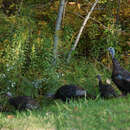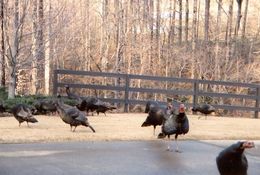-
This photograph taken by a CDC, Div. of Creative Services staff member depicts what has become commonplace in his neighborhood, which is the presence of a flock of wild turkeys, Meleagris gallopavo.Normally, these birds are extremely timid, and highly sensitive to their surroundings, making them very difficult to stalk even by the most experienced of hunters. Even the slightest movement, sometimes hundreds of yards away will cause a wild turkey to immediately fly off, or remain absolutely still for many minutes until it feels its safe to move. Such sightings make it quite evident how animals, which are normally rarely seen, can become accustomed to the presence of humans, and human habitation. Such familiarized interaction can begin to bring into close proximity with human beings, viral and bacterial pathogens carried by such "pseudo-domesticated" animals. Included in the list of such pathogenic organisms are West Nile virus, rabies, malaria and if eaten, salmonella.Created: 2005
-
This photograph taken by a CDC, Div. of Creative Services staff member depicts what has become commonplace in his neighborhood, which is the presence of a flock of wild turkeys, Meleagris gallopavo.Normally, these birds are extremely timid, and highly sensitive to their surroundings, making them very difficult to stalk even by the most experienced of hunters. Even the slightest movement, sometimes hundreds of yards away will cause a wild turkey to immediately fly off, or remain absolutely still for many minutes until it feels its safe to move. Such sightings make it quite evident how animals, which are normally rarely seen, can become accustomed to the presence of humans, and human habitation. Such familiarized interaction can begin to bring into close proximity with human beings, viral and bacterial pathogens carried by such "pseudo-domesticated" animals. Included in the list of such pathogenic organisms are West Nile virus, rabies, malaria and if eaten, salmonella.Created: 2005



